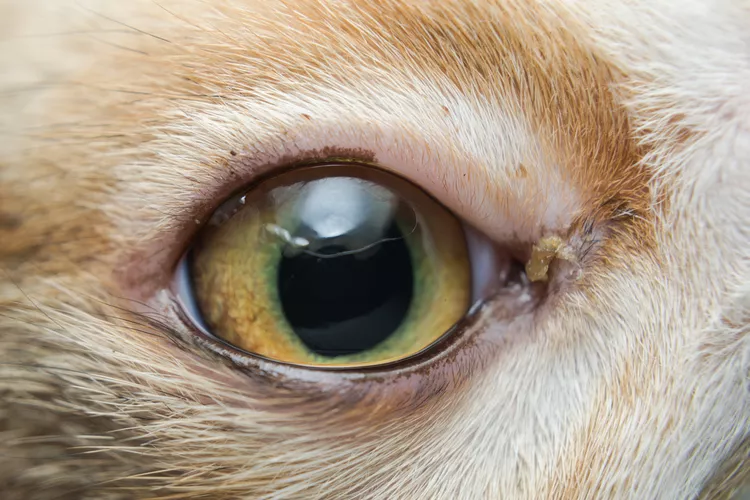Conjunctivitis in Cats

Conjunctivitis is a common eye problem in cats. There are two different kinds of conjunctivitis and several causes of this ocular issue. Cat owners should be familiar with the signs of conjunctivitis to keep their cat comfortable and also prevent it from spreading.
What Is Conjunctivitis?
Commonly referred to as pink eye, conjunctivitis is a problem that affects the eyes of cats. Conjunctivitis causes inflammation of the pink tissues surrounding the eye called the conjunctiva and can affect just one or both eyes at the same time.
Two types of conjunctivitis exist in cats—infectious and non-infectious. Both varieties of conjunctivitis have the same symptoms but are different based on how they are caused.
Symptoms of Conjunctivitis in Cats
Redness and Swelling
One obvious sign of conjunctivitis in a cat is when there is an increase in how red or pink the fleshy part around the eye is. When a cat has conjunctivitis, this part of the eye becomes inflamed and swells.
Squinting and Excessive Blinking
This causes pain and discomfort so the eye will be held shut or a cat will squint or blink excessively because of it.
Discharge and Watering
Sometimes the eye will also water or even develop discharge from the conjunctivitis, leaving the eye area wet or looking dirty.
Rubbing or Pawing
Because a cat with conjunctivitis is uncomfortable, it will often rub its eye on furniture, the carpet, or paw at it to try finding relief.
Sneezing
The infectious type of conjunctivitis, caused by a virus, can cause a variety of respiratory symptoms, including sneezing.
What Causes Conjunctivitis in Cats?
The causes of conjunctivitis determine whether or not it is classified as the infectious or non-infectious type of conjunctivitis.
Viruses
If conjunctivitis is caused by a virus it is considered to be the infectious type. The most commonly seen type of virus that can cause conjunctivitis is the feline herpesvirus type-1, also known as feline viral rhinotracheitis (FVR).
Bacteria
Another type of infectious conjunctivitis is caused by bacteria. Chlamydophila, staphylococci, streptococci bacteria can infect the eyes of cats and cause conjunctivitis along with other issues. These types of infections are also contagious from cat to cat.
Environmental Irritants
Dust, mold, smoke, poor air quality, air fresheners, and other things in a home that could cause eye irritation can cause conjunctivitis. Even pet shampoo and dirt that gets in a cat's eyes can cause conjunctivitis because of how irritating it can be. These things can all cause the non-infectious type of conjunctivitis.
How Do Vets Diagnose Conjunctivitis in Cats?
A veterinarian will perform a full physical examination to determine whether or not a cat has conjunctivitis. Often times conjunctivitis will also occur with other problems including respiratory diseases and other eye issues.
An ophthalmoscope may be used to get a better look at a cat's eye and various tests may also need to be run to ensure there aren't other eye problems associated with the conjunctivitis. Special eye stains and tearing tests are commonly used.
How to Treat Conjunctivitis
The conjunctivitis itself will be treated with special eye drops but the underlying reason for the conjunctivitis may have additional treatments. Immune-boosting supplements, steroids, antibiotics, anti-inflammatories, and other medications may all be recommended depending on the reason for the conjunctivitis. A warm, wet cloth may also help relieve some discomfort and help to clean the affected eye.
Prognosis for Cats with Conjunctivitis
If your cat was diagnosed with the infectious type of conjunctivitis, it will still carry the virus in its system. That only means your cat is prone to relapses.
If your cat has either type of conjunctivitis but it hasn't been treated or it has not cleared up on its own, it could lead to many future problems, including damage to the eye and blindness.
How to Prevent Conjunctivitis
Keeping a clean environment for your cat will help prevent the non-infectious type of conjunctivitis. It may be harder to prevent the infectious type of conjunctivitis, but there are a few steps you can take, especially if you have a multi-cat household:
- Keep infected cats away from other felines to decrease the spread of infectious conjunctivitis.
- Give exposed cats immune supplements that may help to boost their immune systems.
- People should also wash their hands thoroughly after handling an infected cat, even if it's only a single-cat household.
Is Conjunctivitis Contagious to Humans?
Neither the infectious or non-infectious type of conjunctivitis is contagious to humans. However, people can spread infectious conjunctivitis to other cats just by touching them. If a person has pet a cat that has herpesvirus type-1 or obvious conjunctivitis they should always wash their hands before handling any other cat even if they aren't sure if the cat they touched had an infectious type of conjunctivitis. It is better to be safe than sorry and limit a cat's exposure to viruses and bacteria whenever possible.